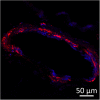Canine Cognitive Dysfunction and Alzheimer's Disease - Two Facets of the Same Disease?
- PMID: 31249505
- PMCID: PMC6582309
- DOI: 10.3389/fnins.2019.00604
Canine Cognitive Dysfunction and Alzheimer's Disease - Two Facets of the Same Disease?
Abstract
Neurodegenerative diseases present a major and increasing burden in the societies worldwide. With aging populations, the prevalence of neurodegenerative diseases is increasing, yet there are no effective cures and very few treatment options are available. Alzheimer's disease is one of the most prevalent neurodegenerative conditions and although the pathology is well studied, the pathogenesis of this debilitating illness is still poorly understood. This is, among other reasons, also due to the lack of good animal models as laboratory rodents do not develop spontaneous neurodegenerative diseases and human Alzheimer's disease is only partially mimicked by transgenic rodent models. On the other hand, older dogs commonly develop canine cognitive dysfunction, a disease that is similar to Alzheimer's disease in many aspects. Dogs show cognitive deficits that could be paralleled to human symptoms such as disorientation, memory loss, changes in behavior, and in their brains, beta amyloid plaques are commonly detected both in extracellular space as senile plaques and around the blood vessels. Dogs could be therefore potentially a very good model for studying pathological process and novel treatment options for Alzheimer's disease. In the present article, we will review the current knowledge about the pathogenesis of canine cognitive dysfunction, its similarities and dissimilarities with Alzheimer's disease, and developments of novel treatments for these two diseases with a focus on canine cognitive dysfunction.
Keywords: Alzheimer’s disease; TAU; amyloid beta; animal model; brain; canine cognitive dysfunction; neurodegeneration; treatment.
Figures



References
Publication types
LinkOut - more resources
Full Text Sources
Other Literature Sources

